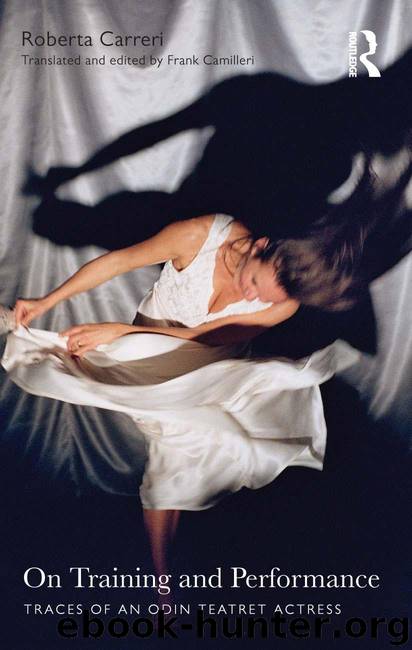On Training and Performance: Traces of an Odin Teatret Actress by Carreri Roberta

Author:Carreri, Roberta [Carreri, Roberta]
Language: eng
Format: azw3
ISBN: 9781317669388
Publisher: Taylor and Francis
Published: 2014-10-23T16:00:00+00:00
A sequence of actions based on images depicting Mary Magdalene.
Subsequently, he suggested that I explore the figure of Judith from the Old Testament. He had read various writings on the complex nature of her story. Judith can be seen as a holy woman who performs a ritual and acts under holy command, or as a cold and calculating woman who falls for Holofernes’ charms and kills him because she cannot resist him. In these two interpretations the sacred and the profane met in the same character. I did not need to think of Mary Magdalene or Salome any longer because Judith included both.
Eugenio set to work to elaborate all the material in relation to the story of Judith. Then he asked me to prepare other material with some objects that he provided himself.
When I showed him the sequence of the Magdalene images accompanied by Silent Night, he suggested substituting the song with a love monologue which we created together from various fragments of different poems.
At Odin Teatret, we follow various routes before we reach the definitive text of a performance. Sometimes we start from a work by a single author, which we can then elaborate radically. At other times it is either Eugenio or one of the actors who writes the text. Often, the director and actors propose poems, novels and newspaper articles from which dialogues and monologues are extracted. At other times we choose the most evocative fragments from an author’s entire work.
The text, just like the performance, emerges from the interaction between the director and the actors.
For Judith, I had gathered a number of poems by Paul Eluard. Eugenio had chosen Friedrich Hebbel’s version of the story where Judith, a young Jewish widow who is rich, beautiful and childless, falls in love with the charismatic figure of the supreme commander of the Assyrian forces, Holofernes, before she kills him to save her people. In the performance I address the love poem to Holofernes’ decapitated head. The physical score that I had originally created on the basis of the Magdalene images underwent changes so that it could be adapted to the new context.
Once, during our rehearsals, Eugenio asked me to show him a scene that I had with Tom Fjordefalk in Come! And the Day Will Be Ours. Then he told me to repeat it following the logic of Butoh dance. In this scene I took off Tom’s Indian poncho, made him wear a white shirt and a pair of shoes, wrapped him up in a military blanket and placed a black hat on his head. How to perform the same sequence without him? After an initial moment of bewilderment, I remembered what Natsu had told me: ‘In a scene you can alternate between being the subject and the object of an action.’ In the case of my sequence with Tom, I was the one performing the actions while he was the object at the receiving end. To do the same thing in his absence I had to alternate between doing and receiving the actions.
Download
This site does not store any files on its server. We only index and link to content provided by other sites. Please contact the content providers to delete copyright contents if any and email us, we'll remove relevant links or contents immediately.
| Acting & Auditioning | Broadway & Musicals |
| Circus | Direction & Production |
| History & Criticism | Miming |
| Playwriting | Puppets & Puppetry |
| Stage Lighting | Stagecraft |
Call Me by Your Name by André Aciman(18964)
Ready Player One by Cline Ernest(12837)
How to Be a Bawse: A Guide to Conquering Life by Lilly Singh(6693)
Wiseguy by Nicholas Pileggi(4586)
The Kite Runner by Khaled Hosseini(4432)
On Writing A Memoir of the Craft by Stephen King(4213)
The Crown by Robert Lacey(4105)
Audition by Ryu Murakami(4098)
Call me by your name by Andre Aciman(4072)
Harry Potter and the Cursed Child: The Journey by Harry Potter Theatrical Productions(3962)
Gerald's Game by Stephen King(3918)
The Perils of Being Moderately Famous by Soha Ali Khan(3782)
Dialogue by Robert McKee(3582)
Dynamic Alignment Through Imagery by Eric Franklin(3488)
Apollo 8 by Jeffrey Kluger(3199)
How to be Champion: My Autobiography by Sarah Millican(3186)
Seriously... I'm Kidding by Ellen DeGeneres(3100)
Darker by E L James(3088)
History of Dance, 2E by Gayle Kassing(3000)
